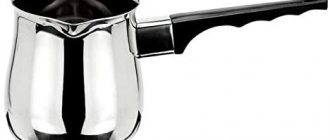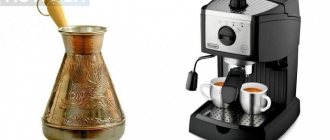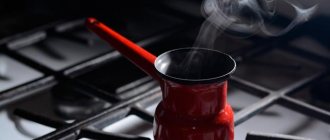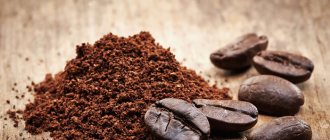Copper utensils have been known for a very long time, and even in many historical excavations, the first kitchen utensils were made of copper. There is a lot of talk around her. They say that it is quite harmful. Although there are people who say that all these ideas about harm are simply nothing more than exaggerated, incorrect facts.
Set of copper utensils.
Copper in the kitchen
Copper dishes look very attractive. That is why she is the guest of honor in the kitchen. Spoons, bowls for making desserts and jam, and most importantly, for coffee lovers - a Turk. These are all essential attributes of any kitchen. The metal is believed to have antibacterial properties, some of which have already been proven by scientists. It can remove various fungi and bacteria from water and other products. There are even confirmed facts that it removes E. coli and salmonellosis. Therefore, the appearance of copper utensils in the kitchen is not such a surprising fact.
The benefits of dishes
Of the beneficial properties, it is worth noting not only visual beauty. There are other advantages. Thus, copper cookware is very thermally conductive. That is why it is indispensable for preparing various sauces, jams and seafood. Due to the fact that heating occurs evenly and very quickly, a large number of beneficial properties of different products are preserved. It is believed that microparticles get into various products and give them a certain, unusual taste.
This metal is a good antibacterial agent. It is known that in ancient times they even specially stored water in such pans in order to disinfect it.
Copper itself is quite light, especially when it comes to special alloys, such as brass. These properties are complemented by many others. At the same time, it remains strong and durable so much that it can even be passed on from generation to generation.
Negative qualities
It is worth mentioning that this metal has several negative properties. For example, some fruit acids, upon contact with a copper surface, oxidize and release harmful substances to the body, which can even lead to poisoning. After cooking, you need to remove food from copper containers to avoid oversaturation with these elements.
Excess moisture may cause copper to develop a patina. This is a greenish coating that is released upon contact with abundant moisture. You absolutely cannot cook in dishes with such defects. They do not appear on brass products.
A large amount of copper in the body is fraught with nutritional disorders. Children, as well as those with liver problems, should not eat from dishes made from such material, because they are very susceptible to the influence of excess copper.
Another important disadvantage is the rather high cost of the dishes. But you need to think about the fact that for the big money that kitchen utensils cost, you can leave an inheritance even to a generation of grandchildren.
Metal properties and positive qualities
Copper cookware is loved for its aesthetic appearance ; cooking in it is a pleasure. Such utensils can serve as interior items and decorate the kitchen. It is often a family heirloom that has been kept in the home for years. But in addition to aesthetics, copper cookware has positive properties that not only do not harm the body, but also contribute to improvement, and the properties of the metal are highly valued by famous chefs.
Nowadays copper utensils are covered with a special protective coating. It also happens that copper utensils are used without any protective coating at all, for example, when preparing egg dishes. Eggs thicken much better when in contact with copper, so egg desserts and creams are prepared only in uncoated copper dishes.
- When heated, the alloy distributes heat evenly , so food has the same degree of cooking regardless of its location on the heating surface.
- Also, due to the fairly high thermal conductivity of metal, it can be cooked on minimal heat, and accordingly the cooking speed is very high.
- It is believed that copper products can kill bacteria, which is also important for a healthy diet.
- As you know, copper is an essential element in the body .
Types of copper utensils
Copper itself is a rather soft and expensive metal, so kitchen utensils made from pure copper are very expensive and not of very high quality. Various compositions are often created that help preserve the properties of copper, but at the same time improve them as much as possible. The most common are a mixture of copper and zinc called brass; copper and nickel, which is cupronickel, and nickel silver is a mixture of copper, zinc and nickel.
Utensils made of copper.
Among the large number of copper kitchen utensils, the most practical are:
- pots, which can be of different volumes and depths;
- frying pans with handles or high sides;
- thick-bottomed saucepans;
- teapots;
- samovars;
- Turks;
- gravy boats;
- buckets;
- sugar bowls;
- candy bowls;
- cutlery.
Trays of different types, thicknesses and shapes are perfect for serving. All these samples of kitchen utensils can be made of brass.
Inner coating
Copper cookware oxidizes very quickly, so it must be chosen so that there is a coating of another metal inside. Most often it is stainless steel or tin. The stainless steel must be dense inside, and on the outside the copper layer retains all its useful and thermally conductive properties.
Cookware with inner coating.
Copper utensils are often coated with tin, the so-called tinned copper. Because of this, a rather dense layer is obtained, which helps to improve all the properties of this noble metal. Chefs often use just such dishes, because they are very easy to restore by repeating the tinning procedure.
Without inner covering
If you buy copper cookware without an internal coating, you need to understand that many unscrupulous sellers can pass off a mixture of another metal with a thin layer of copper plating as the original. Copper cookware is quite heavy, uniform and looks very expensive. Often, imitation stainless steel is sold under the guise of uncoated copper.
In its pure form, copper utensils can only be used for preparing cold dishes, boiling clean water and creating desserts, such as jam, which will then be placed in another container.
Care methods
Copper cookware retains its attractive appearance only until the first cooking in it. In order for the use of products to continue to be a pleasure over time, it is necessary to handle them competently. With proper care, copper kitchen utensils can last for many years.
Basic operating rules and tips on how to care for copper cookware:
- use the products carefully and carefully, avoid falls, since copper is a soft metal;
- Avoid using metal spatulas when cooking to avoid cracks and scratches;
- wash dishes only by hand; do not place them in dishwashers, as strong cleaning agents can damage the color of copper utensils;
- For cleaning, it is recommended to use only soapy water and do not use all-purpose chemicals with chlorine;
- water temperature for washing is 40-50 °C, too hot can damage the structure of the dishes;
- To give the dishes a sparkling shine, it is prohibited to use cleaning products with an abrasive composition, hard brushes and graters. A special paste for copper is more suitable; you can use a mixture of flour, salt and water for this purpose;
- After washing, you should thoroughly wipe the products dry;
- clean utensils should be stored in a closet, hanging or upside down on a rack;
- should be stored in a dry environment and avoid exposure to steam to prevent oxidation of copper and the formation of a patina dangerous to the body;
- dishes without liquid, completely empty, must not be left on an open fire on the stove;
- In order not to damage the protective inner layer, dry utensils should be rinsed and only then pour boiling water;
- You can add salt to water or broth only after the liquid has boiled;
- To prevent and protect against oxidation during storage, you need to coat the dishes with antioxidant compounds; the product must be washed off before cooking.
By following these simple rules, you can extend the service life of pots and pans made of copper and its alloys for many years. To ensure that copper kitchen utensils do not lose their noble appearance, they must be regularly cleaned to a shine. This is the only way to protect the item from the appearance of blue-green patina and unpleasant stains. For such purposes, there are ready-made pastes or polishes. However, you can achieve a mirror shine using improvised means that are present in the arsenal of any housewife.
Before you start cleaning copper cookware at home, you should carefully study what ingredients you may need and what the sequence of work is. All actions must be carried out in compliance with safety regulations, and you must wear protective gloves on your hands.
Regular tomatoes will help restore copper utensils to their former shine. The process will take two to three minutes:
- Apply a small amount of ketchup or tomato paste to the stain.
- Leave on the dish for 1-2 minutes.
- Wash off with warm soapy water.
In this way, you can remove old dirt and remove dark spots. Often, after improper use, copper utensils begin to lose their novelty and attractiveness, to avoid this you need to do the following:
- Mix salt and vinegar in equal proportions.
- Apply the mixture to problem areas.
- Leave to act for 1-2 minutes.
- Rinse with warm water and wipe dry.
- Polish until shiny with a piece of genuine leather.
The method is excellent for removing contaminants in grooves and joints on copper cookware. You can use lemon and salt to clean copper cookware. Despite the fact that you cannot cook sour things in copper containers, this method of care has an incredible effect:
- Take a lemon and cut it in half.
- Dip the citrus in salt.
- Rub the surface to be treated.
- Leave for a few minutes.
- Wipe with a damp cloth or rinse with warm water.
This method of cleaning large surfaces is suitable if the dishes do not fit into the washing container. A vinegar and water solution will help remove stubborn stains, blackness and fingerprints after repeated use.
Ingredients:
- vinegar – 100 ml;
- salt – 1 tbsp;
- water – 600 ml.
Procedure:
- Mix the ingredients.
- Take a piece of fabric that does not leave fibers.
- Moisten the cloth in the resulting mixture and rub the surface to be treated. If the utensil is small, you can completely place it in the solution.
- Leave for 20-30 minutes; if fully immersed, reduce exposure time to 10 minutes.
- Rinse under warm running water.
These simple methods will help keep copper cookware in perfect condition for quite a long time. Remember that cleaning must be done regularly.
Copper utensils should only be washed in warm water.
Lubricate copper with special products
Wipe the surface of the cookware with a dry cloth as often as possible
Lemon, baking soda and vinegar are used to clean copper cookware
Secrets of choosing copper cookware
In order to use this metal correctly, many chefs share their secrets of choice. You need to understand that even the highest cost product will undoubtedly justify itself, because copper cookware is an extremely long-term investment. Copper utensils are always sold without lids, and you can hardly buy them from Russian manufacturers.
Set of pots and pans made of copper.
It is better to choose forged copper cookware; it will last much longer. Available in tin, steel or nickel plating. But you should understand that these containers are more suitable for quick cooking or boiling.
Copper as a decorative element
Copper is a metal that has deservedly become popular. What is made from copper? It is attractive and recognizable, easy to process, which means it can be given completely different shapes. Designers love it for this feature and actively use copper in the interior of apartments and houses:
- If your home is decorated in Loft or Retro style, copper elements will harmoniously fit into the interior. These can be either drainpipes on a rough surface that imitates brickwork, or open wiring.
- Copper lamps are used everywhere in the interior. They will look great both in the office and in the living room. A combination with soft textures, for example, with a voluminous blanket on a sofa or armchair, will add special chic.
- Whole sheets of this metal are used to decorate walls in styles such as Minimalism or Neoclassicism. With the help of a perfectly polished surface, you can get the effect of visually expanding the space, because it will reflect the sun's rays and fill the room with light.
- Copper baths and sinks are not only stylish, but also practical, since the metal is not afraid of water and does not corrode.
- Lately, copper furniture has come into fashion. The chairs are suitable for a dining room or office, and a bed with a copper headboard has long been a fixture in bedrooms designed in a modern style.
Important! Copper can be of completely different shades - pink and red, yellow and orange. Due to this, decorative items and furniture can be combined with any interior. It will be very difficult to make a mistake with the color shades of your home decoration.
Using copper cookware in the kitchen is the best stylistic solution. Original pots and saucepans, giving a soft and warm shine, fit perfectly into the Country style. Provence and Rustic also succinctly and very successfully take on copper elements:
- Tan-colored dishes can be hung on brackets or placed on hooks on the wall. In this case, the stylistic effect will be much stronger.
- Copper tint can be present in the interior in the form of fittings curved into a ring or arc on the kitchen set. The warm color looks especially stylish on white facades.
- Even the countertop in the kitchen can be copper. This is a very practical solution for those who love perfect order.
- If you adore originality and love folk motifs, then a samovar that will stand in the middle of the dining table will please the eye every day and your guests will certainly appreciate it.
- The soft green color goes well with the warm shade of copper. Therefore, for bright and expressive accents, designers often use pots with indoor plants or decorate the kitchen with pots and vases.
Important! Even for the interior, it is best to purchase copper cookware from trusted manufacturers and even at a flea market. Never fall for low prices and great deals on Chinese websites. As a rule, such dishes are made not from copper, but from alloys of mysterious origin. Such copper utensils are harmful to health.
Using copper utensils correctly
There are a number of important conditions that must be observed in order not to cause harm. The prepared dish in copper dishes is more tasty, but it must be taken into account that food cannot be stored in it for a long time. This is especially true for sour foods or those that contain acid, and even fruits.
Empty dishes without contents should not be left on the fire to avoid cracks. Copper likes a good cleaning, but does not tolerate abrasives or heavy scratches. Therefore, you need to use silicone or wooden spatulas for cooking.
Symptoms of copper poisoning
Copper is a normal component that is important for the development of the body, but only a small amount is needed. Usually people get it from various products, but in case of excess, which occurs due to the ingestion of large amounts of copper salts, there can be serious consequences, including poisoning.
The first symptoms are a sharp drop in blood pressure, weakness, diarrhea, abdominal pain, as well as a metallic taste and vomiting. In very advanced situations of poisoning, there may even be breathing problems and convulsions. Very often these symptoms are similar to liver diseases, which is primarily affected by copper.
Weakness and fatigue are the first signs of copper poisoning.
A few words about the manufacturers
Once again it is worth noting the fact that the cost of the product is quite high. Russian, Ukrainian and Belarusian manufacturers do not produce such elements on a mass scale. This doesn't justify itself at all.
But there are several famous European companies that create good copper cookware. These are the Portuguese Bioflon, the Italian Ruffoni, the French Mauviel and De Buyer, as well as the Italian manufacturer TVS.
It is necessary to understand that even despite the high cost, this dish will justify the expense, because it will live for more than one day and will be inherited by more children and grandchildren.
Care and cleaning
It is necessary to take care of copper utensils so that their bright appearance does not suffer and remains that way for as long as possible. There are several ways to properly care for it:
- No ordinary cleaning products, chlorine powders or hard sponges should be used, because they will scratch the delicate coating.
- You need to know that copper cannot be left wet at all; a green coating immediately appears on it, which is harmful.
To clean copper surfaces, it is best to use lemon, citric acid, vinegar, salt or soda. To clean copper, you need to cut the lemon into slices and rub the dishes well, then rinse under running water. This product helps clean almost any copper utensil.
By analogy, vinegar and soda are used. Very often, cleaning dishes in a citric acid solution helps restore the dishes to their original appearance. It is worth understanding that any mechanical damage causes irreparable harm to the coating.
Negative qualities
In addition to the positive properties, copper metal utensils have several disadvantages. Scientists have identified several negative qualities that can harm health.
- The presence of acids in vegetables and fruits. Under the influence of copper, the beneficial vitamin is destroyed.
- You cannot store fruit, vegetable and berry products in metal containers, as fatty acids will oxidize, which can cause cancer.
- The greatest harm is possible when storing dishes in an environment with high humidity. It will cause a green coating to appear on the surface, which indicates oxidation.
- Plaque occurs when food acids are heated; in addition, when exposed to heat, acids produce substances that are very harmful to humans. If plaque appears on the walls of the dishes, remove it by wiping it with salt soaked in vinegar.
- The high price and special care make daily use of copper-based cookware inconvenient. On store shelves, metal utensils shine, and when people buy a saucepan, they discover a protective film on the outside that must be washed off before the first cooking. After that, it will have to be cleaned every time after its use.
Containers made of this material are contraindicated for preparing food intended for small children or people with alcohol addiction. In infants, this substance can cause liver disease. When drinking alcohol, this chemical element enters the body and is absorbed in large quantities, which can lead to cirrhosis of the liver.











